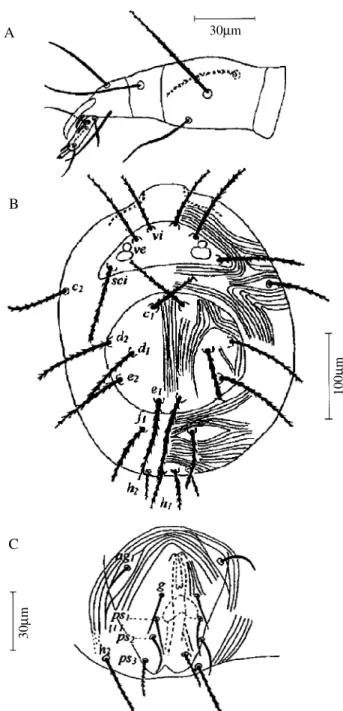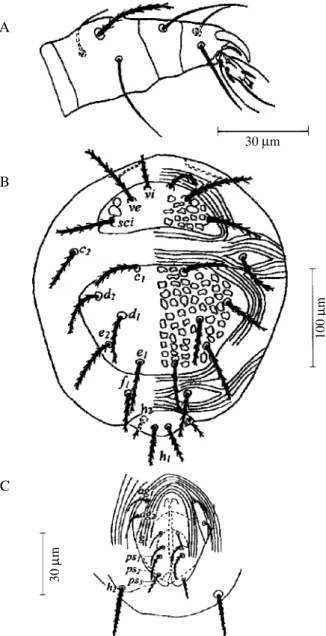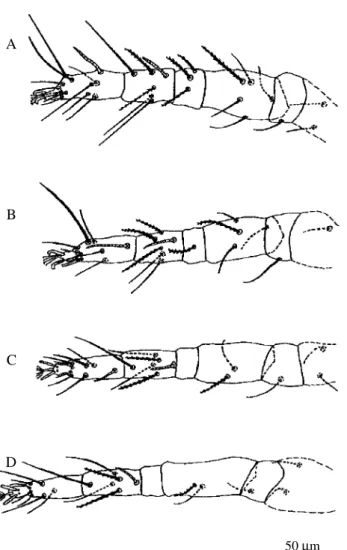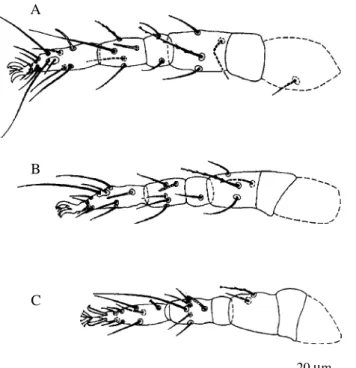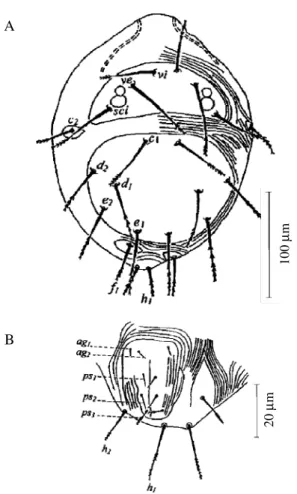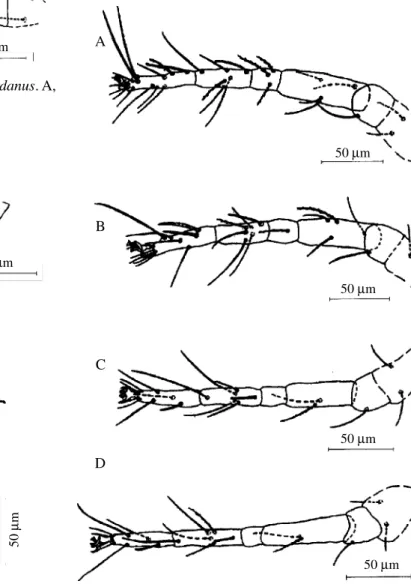SYSTEMATICS, MORPHOLOGY AND PHYSIOLOGY
Stigmaeidae Mites (Acari: Raphignathoidea) from Arecaceae of the
Atlantic Forest in São Paulo State, Brazil
G
ERALDOP.
DEA
RRUDAF
ILHO1ANDG
ILBERTOJ.
DEM
ORAES2Depto. Entomologia, Fitopatologia e Zoologia Agrícola, ESALQ/USP, 13418-900, Piracicaba, SP 1e-mail: gparruda@carpa.ciagri.usp.br, Bolsista CNPq
2e-mail: gjmoraes@carpa.ciagri.usp.br, Pesquisador CNPq Neotropical Entomology 32(1):049-057 (2003)
Ácaros Stigmaeidae (Acari: Raphignathoidea) de Arecaceae da Mata Atlântica do Estado de São Paulo
RESUMO - Este trabalho registra os ácaros Stigmaeidae encontrados em plantas nativas da família Arecaceae em áreas da Mata Atlântica do estado de São Paulo. Foram realizadas quatro coletas, uma em cada estação, no ano 2000 em Cananéia, Pariquera-Açu, Piracicaba e São Pedro, em nove espécies nativas de palmeiras. Duas espécies novas de Stigmaeidae foram encontradas e descritas, Agistemus palmae sp. n. e Agistemus caissara sp. n. Com base em espécimes originários do estado de Mato Grosso, estágios imaturos de Agistemus floridanus Gonzalez-Rodriguez, 1965 são descritos pela primeira vez, enquanto machos e fêmeas adultas da mesma espécie são redescritos.
PALAVRAS-CHAVE: Taxonomia, controle biológico, predador
ABSTRACT - This work reports the Stigmaeidae mites from native plants of the family Arecaceae, in areas of Atlantic Forest in the State of São Paulo. Samplings were conducted once in each season of the year 2000 in Cananéia, Pariquera-Açu, Piracicaba and São Pedro, on nine native species of palm trees. Two new species of Stigmaeidae were found and described, Agistemus palmae n. sp. and Agistemus caissara n. sp. Based on specimens from the State of Mato Grosso, Brazil, immature stages of Agistemus floridanus Gonzalez-Rodriguez, 1965 are described for the first time, while adult males and females of the same species are redescribed
KEY WORDS: Taxonomy, biological control, predator
The diversity of mites on palm trees (Arecaceae) is still little known in Brazil. Reports of mites on those plants were published by Aquino & Arruda (1967), Flechtmann (1967, 1994), Ferreira (1987), Santana et al. (1994), Santana & Flechtmann (1988), Gondin Jr. et al. (2000), and Gondin Jr. & Moraes (2001).
Stigmaeidae is the second most frequent and abundant group of predatory mites on plant leaves, after Phytoseiidae. Preliminary observations have indicated that the former are also frequently found on leaves of palm trees in the Atlantic Forest of the State of São Paulo. Those mites are generally orange, yellowish, greenish or reddish. They are characterized by having the so called “thumb-claw” process, chelicera with stylet-like movable digit; dorsal shields frequently present, ventral shields absent; coxae I and II distinctly separated from coxae III and IV, and genital and anal openings contiguous (Flechtmann 1975, Krantz 1978).
A few stigmaeid mites have been reported from Brazil. In the State of São Paulo, mites of this group were reported by Flechtmann (1968, 1981, 1985), Vila & Flechtmann (1970), Chiavegato (1972), Feres (2000), Mineiro & Moraes
(2002) and Matioli et al. (2002). Flechtmann (1995) described a new stigmaeid from the State of Rio de Janeiro. Ferla & Moraes (1998) reported two species from the State of Rio Grande do Sul.
Some stigmaeids of the genera Agistemus Summers and Zetzellia Oudemans have been reported to prey on phytophagous mites of the families Eriophyidae, Tetranychidae and Tenuipalpidae (Santos & Laing 1985, Gerson & Smiley 1990). N.J. Ferla (personnal communication) studied the biology of Agistemus floridanus Gonzalez-Rodriguez collected on rubber trees (Hevea brasiliensis Muell. Arg.) in the State of Mato Grosso. He concluded that this mite can be more important in controlling Calacarus heveae Feres (Eriophyidae) and Tenuipalpus heveae Baker (Tenuipalpidae) than other predators found on the same substrate.
Figure 1. Adult female of Agistemus palmae sp. n. A, right palp; B, dorsum of idiosoma; C, anogenital region. Material and Methods
A survey of stigmaeid mites was carried out in Cananéia, Pariquera-Açú, Piracicaba and São Pedro counties, State of São Paulo, Brazil, from January to November 2000.
Nine species of native palm trees were sampled in those locations: Euterpe edulis Mart., Syagrus oleracea (Mart.) Becc., Syagrus romanzoffiana (Cham.), Attalea dubia (Mart.) Burret, Acrocomia aculeata (Jacq.) Lodd., Geonoma schottiana Mart., Geonoma brevispatha Barb. Rodr., Astrocarium aculeatissimum (Schott) Burret and Bactris setosa Mart. These species are among the most common palm trees in those locations. Samples of each plant consisted of the terminal shoot (only developing leaves were taken, without removing the apical meristem) and 20 leaflets taken from a single median leaf of the plant crown (five from the apical third, 10 from the median third and five from the basal third). Whenever present, 20 rachillae (ramifications of the main inflorescence axis) and 20 fruits were also randomly collected per plant. The leaflets of each leaf were placed into a paper bag, which was then placed into a plastic bag and stored in a cool box (12-21ºC) to prevent mite loss during transportation. Fruits, flowers and terminal shoots were placed into 5-liter plastic containers 30% filled with 70% ethanol. Immediately after placing the plant parts, the containers were shaken to immobilize the mites and drop them in the solution.
To collect the mites, the leaflets were examined directly under stereomicroscope and the ethanol was passed through a fine sieve which was in turn examined under stereomicroscope. Mites collected were mounted on microscope slides for identification. Measurements of the new species described in this paper are in micrometers.
All specimens were collected by G. P. Arruda Filho. Types of the new species were deposited in “Setor de Zoologia, Departamento de Entomologia, Fitopatologia e Zoologia Agrícola, University of São Paulo / ESALQ”, Piracicaba. Representatives of other species found were deposited in the same institution.
Results and Discussion
Agistemus palmae Arruda Filho & Moraes, sp. n.
(Figs. 1-2)
Diagnosis. This species differs from Agistemus striolatus
Gonzalez-Rodriguez, 1965 by the larger ratios vi/vi-vi and cI /c
I-cI (2.6 x 2.0 and 2.5 x 1.0, respectively) and the shorter h2 (25-28 in the new species and 30.5 in A. striolatus). It also differs from Agistemus brideliae Gonzalez-Rodriguez, 1965 by the lightly scletotized and longitudinally striate median hysterosomal plate.
Adult Female. Gnathosoma (Fig. 1A): palp femur with three
setae, two of which are hairy; genu with only one seta; tibia with two setiform and two claw-like (accessory and terminal claws) setae; tarsus with six setae, including one solenidium and one trifurcate sensillum. Propodosoma (Fig. 1B): propodosomal plate entire, smooth, with three pairs of hairy setae (vi, ve and sci) and a pair of post-ocular bodies; pre-ocular seta (ve) approximately
as long (103-108) as the dorsolateral seta e2 (103-105); vi=75, sci=95-98, vi-vi=28-30, vi-ve=28, ve-sci=40. Hysterosoma (Fig. 1B): median dorsal plate lightly sclerotized, with discrete longitudinal striae and five pairs of setae; dorsal setae elongate, hairy and inserted on small tubercles; c1=83-88, c2=75-78, d1=85-90, e1=100-103, d2=95-98, c1-c1=33-35, c1-d1=63-65, e1 -e1 =25-30, d2-e2=50; setae f1 (73-75) on intercalary plates; supra-anal plate: h1=43, h2=25-28, h1-h
1=15. Ventral region of opistosoma (Fig. 1C): four pairs of anogenital setae (g, ps1, ps2, ps
3) and one pair of aggenital setae (ag). Legs (Fig. 2): chaetotaxy from coxa to tarsus (solenidia in parentheses): I - 2 - 1 - 5 - 3 - 5 (1) - 12 (1); II - 1 - 1 - 4 - 1 - 5 (1) - 9 (1); III - 2 - 1 - 2 - 0 - 5 (1) - 7 (1); IV - 2 - 1 - 2 - 0 - 6 (1) – 7.
A
C
30µm
B
100
µ
m
30
µ
Figure 3. Adult female of Agistemus caissara sp. n. A, left palp; B, dorsum of idiosoma; C, anogenital region. Figure 2. Legs of adult female of Agistemus palmae sp.
n. A, leg I; B, leg II; C, leg III; D, leg IV.
Adult Male. Unknown
Type-Material. Holotype and paratype females, on leaflets of Syagrus oleracea, São Pedro, State of São Paulo, 16-V-2000, G. P. de Arruda Filho
Etymology. palmae refers to the common name of the family
(Arecaceae) to which S. oleracea belongs.
Agistemus caissara Arruda Filho & Moraes, sp. n.
(Figs. 3-4)
Diagnosis. This species differs from Agistemus
novazelandicus Gonzalez-Rodriguez, 1963 by having sci more than twice as long as c2, much shorter h2, shorter hairy seta of the femur I, two hairy setae on tibiae I and II, c2 shorter than c1 and d1, and ps3 longer than other anogenital setae.
Adult Female. Gnathosoma (Fig. 3A): palp femur with two
dorsal setae, one of which hairy, and one ventral seta; genu with only one dorsal seta; tibia with two setiform and two claw-like (accessory and terminal claws) setae; tarsus with seven setae, including two solenidia and one trifurcate sensillum. Propodosoma (Fig. 3B): propodosomal plate entire, areolate, with three pairs of hairy setae (vi, ve and sci) and a pair of post-ocular bodies; vi= 30, ve= 61, sci= 56, vi-vi= 25, vi-ve= 20, ve-sci= 30. Hysterosoma (Fig. 3B): median dorsal plate well
scletotized and areolate, with five pairs of setae; dorsal setae robust and hairy; c1 =44, c2 (22), d1=44, e1=51, d2=49, e2=57, c1-c1=49, c1-d1=52, e1-e1=33, d2-e2=53; setae f1 (40) on intercalary plates; supra-anal plate: h1=32, h2=22, h1-h1=9. Ventral region of opistosoma (Fig.3C): four pairs of anogenital setae (g, ps, ps2, ps3) and two pairs of aggenital setae (ag1 and ag2). Legs (Fig. 4): chaetotaxy from coxa to tarsus (solenidia in parentheses): I - 2 - 1 - 5 - 3 - 5 (1) - 12 (1); II - 1 - 1 - 4 - 1 - 5 (1) - 9 (1); III - 2 - 1 - 2 - 0 - 4 (1) - 7 (1); IV - 2 - 1 -2 - 0 - 5 (1) - 7.
Adult Male. Unknown
Type-Material. Holotype female on leaflet of Astrocarium
aculeatissimum, Cananéia, State of São Paulo, 12-VII-2000, G. P. de Arruda Filho
Etymology. caissara refers to the inhabitants of Cananéia.
50 µm
A
B
C
D
A
B
C
30 µm
100
µ
m
30
µ
Figure 5. Larva of Agistemus floridanus. A, dorsum of idiosoma; B, anal region.
Agistemus floridanus Gonzalez-Rodriguez
A. floridanus Gonzalez-Rodriguez, 1965: 42.
Distribution. Brazil, Costa Rica, Mexico and United States
of America
Specimens Examined. Cananéia, A. aculeatissimum
VII-2000, X-2000; G. schottiana I-VII-2000, IV-VII-2000, VII-2000; S. romanzoffiana IV-2000, VII-2000, X-2000; Pariquera-Açu, A. aculeatissimum I-2000, 2000; S. romanzoffiana IV-2000, 2000; E. edulis IV-IV-2000, 2000; A. dubia VII-2000; Piracicaba, A. aculeata II-2000, V-2000, XI-VII-2000; E. edulis II-2000, 2000; S. romanzoffiana VIII-2000, XI-2000; one female identified as A. floridanus on a microscope slide indicating “Paratype series; R. H. Gonzalez, 20/7/60, Parrish Fruit, Florida”, of Florida State Collection of Arthropods (F.S.C.A) and two males on a microscope slide indicating “Paratypes, 06/1/53, Lake Alfred, Florida”, of F.S.C.A.
Observations. Sixty-one adult females of this species were
found; 15 of those were measured. Seta ve of the specimens collected is ca. twice as long as the distance ve-sci , instead
of at most 1.5 times longer, indicated in the key of the paper containing the original description of the species. In the female paratype examined in this study, seta ve is ca. 1.7 times longer than the distance ve-sci. Similarly to that paratype, the females collected have d2 approximately 1.3 times longer than the distance d2-e2. In the original description, this seta is mentioned to be as long as or shorter than the distance d2-e2. Descriptions of the larva, protonymph and deutonymph as well as redescriptions of adult females and males are subsequently provided. Those are based on specimens reared in the laboratory from a population identified as A. floridadnus, collected on H. brasiliensis in the State of Mato Grosso.
Larva (n = 4). Prodorsum (Fig. 5A): propodosomal plate entire,
smooth, with three pairs of setae and a pair of post-ocular bodies; vi=28-29; ve=45-50 and sci=40-43. Hysterosoma (Fig. 5A): median dorsal plate absent; setae c1, d1 and d2 individually inserted on small plates; setae e1 and e2inserted on a single plate: c1=35-39, c2=21-23, d1=35-38, d2=35-38, e1=35-40, e2=34-38, f1=21-23, h1=13-15 and h2=13-14. Ventral region of opistosoma (Fig. 5B): three pairs of anal setae (ps1, ps2 and ps3). Legs (Fig. 6): chaetotaxy from coxa to tarsus (solenidia in parentheses): I - 1 - 0 - 4 - 2 - 4 (1) - 11 (2); II - 0 - 0 - 4 - 1-4 (1) - 8 (2); III - 0 - 0 - 2 - 0 - 5 (1) - 8.
Figure 4. Legs of adult female of Agistemus caissara sp. n. A, leg I; B, leg II; C, leg III; D, leg IV.
50 µm
A
B
C
D
A
B
50
µ
m
20
µ
Figure 6. Legs of larva of Agistemus floridanus. A, leg I; B, leg II; C, leg III.
Protonymph (n = 4).Prodorsum (Fig. 7A): propodosomal
plate entire, smooth, with three pairs of setae and a pair of post-ocular bodies; vi=30-35; ve=45-53; sci=43-48. Hysterosoma (Fig. 7A): median dorsal plate smooth; humeral (c2) and intercalary (f1) setae inserted on separate plates: c1 =36-43, c2=23-28, d1=36-40, d2=33-38, e1=40-44, e2=39-43, f1 =23-25, h1=13-18, h2=9-11. Ventral region of opistosoma (Fig. 7B): three pairs of anal setae (ps1, ps2 and ps3) and one pair of aggenital setae (ag1). Legs (Fig. 8): chaetotaxy from coxa to tarsus (solenidia in parentheses): I 2 0 4 3 5 (1) -12 (1); II - 0 - 0 - 4 - 1 - 5 (1) - 8 (1); III - 2 - 0 - 2 - 0 - 5 (1) - 7 (1); IV - 0 - 0 - 1 - 0 - 5 (1) - 6.
Deutonymph (n = 2). Prodorsum (Fig. 9A): propodosomal
plate entire, smooth, with three pairs of setae and a pair of post-ocular bodies; vi=38; ve=59; sci=46-53. Hysterosoma (Fig 9A): median dorsal plate smooth; humeral (c2) and intercalary (f1) setae inserted on separate plates: c1=45-50, c2=28-35, d1=43-48, d2=40-43, e1=45-50, e2=45-48, f1=28-33, h1 =18-23, h2=15. Ventral region of the opistosoma (Fig. 9B): three pairs of anal setae (ps1, ps2 and ps3) and two pairs of aggenital setae (ag1 and ag2). Legs (Fig. 10): chaetotaxy from coxa to tarsus (solenidia in parentheses): I - 2 - 1 - 5 - 4 - 5 (1) - 12 (1); II - 1 - 1 - 4 - 1 - 5 (1) - 9 (1); III - 2 - 1 - 2 - 0 - 5 (1) - 7 (1); IV - 2 - 0 - 2 - 0 - 5 (1) - 7.
Adult Female (n = 4). Gnathosoma (Fig. 11A): palp femur
with three setae, one of which is hairy; genu with only one, hairy seta; tibia with two setiform and two claw-like (accessory and terminal claws) setae; tarsus with seven setae, including two solenidia and one trifurcate sensillum. Propodosoma (Fig. 11B): propodosomal plate entire, smooth, with three pairs of setae (vi, ve and sci) inserted on small tubercles and a pair of
Figure 7. Protonymph of Agistemus floridanus. A, dorsum of idiosoma; B, anal region.
Figure 8. Legs of protonymph of Agistemus floridanus. A, leg I; B, leg II; C, leg III; D, leg IV.
A
B
C
20 µm
50
µ
m
20
µ
m
A
B
50 µm
A
50 µm 50 µm 50 µm
B
C
Figure 11. Adult female Agistemus floridanus. A, right palp; B, dorsum of idiosoma; C, anogenital region.
post-ocular bodies; ve is the longest of the propodosomal setae. Hysterosoma (Fig. 11B): median dorsal plate smooth; dorsal setae inserted on small tubercles, conspicuously hairy and tapering; humeral (c2) and intercalary (f1) setae inserted on separate plates. Ventral region of opistosoma (Fig. 11C): four pairs of anogenital setae (g, ps1, ps2and ps3) and two pairs of aggenital setae (ag1 and ag2). Measurements of the specimens collected in this study, followed (in parentheses) by measurements of one paratype are: idiossoma=305-310 (290), ratio vi/vi-vi=1.6 (1.3), vi=38 (40), ve=63-64 (60), ve-sci=28-30 (33), sci=55-58 (58), c1=48-50 (48), c1-d
1=53-58 (53), c2 =43-49, d1=48-54 (49), d2=49-50 (53), d2-e2=40-43 (40), e1=51-55 (55), e1-e1=25-33 (30), e2=52-55 (55), f1=46-49 (52), h1=30-33 (35), h1-h1=9-14 (13), h2=23-24 (20). Legs (Fig. 12): chaetotaxy from coxa to tarsus (solenidia in parentheses): I - 2 - 1 - 5 - 3 - 5 (1) -12 (1); II - 1 - 1 - 4 - 1 - 5 (1) - 9 (1); III - 2 - 1 - 2 - 0 - 5 (1) - 7 (1); IV - 2 - 1 - 2 - 0 - 5 (1) - 7.
Adult Male. Gnathosoma (Fig. 13A): palp femur with three
setae, one of which is hairy; genu with only one, smooth seta; tibia with two setiform and two claw-like (accessory and Figure 9. Deutonymph of Agistemus floridanus. A,
dorsum of idiosoma; B, anal region.
Figure 10. Legs of deutonymph of Agistemus floridanus. A, leg I; B, leg II; C, leg III; D, leg IV.
100
µ
m
20
µ
m
A
B
A
50 µm
B
C
D
20
µ
m
A
30 µm
B
C
100
µ
Figure 13. Adult male Agistemus floridanus. A, right palp; B, dorsum of idiosomal.
Figure 12. Legs of adult female Agistemus floridanus. A, leg I; B, leg II; C, leg III; D, leg IV.
terminal claws) setae; tarsus with seven setae, including two solenidia and one trifurcate sensillum. Propodosoma (Fig. 13B): propodossomal plate entire, smooth, with three pairs of setae (vi, ve and sci) inserted on small tubercles and a pair of post-ocular bodies; ve is the longest of the propodosomal setae. Hysterosoma (Fig. 13B): median dorsal plate smooth; dorsal setae inserted on small tubercles, conspicuously hairy and tapering; intercalary setae inserted on median plate. Measurements of the specimens collected in this study, followed (in parentheses) by measurements of two paratypes are: vi=30-35 (33-35), vi-vi=23-25 (28-35), vi-ve=23-25 (21-23), ve=45-53 (51), ve-sci=33-35 (28-30), sci=40-46 (40-45), c1=40-43 (30-38), c1-d1=48-62 (43-48), c2=30-34 (33-40), d1=28-33 (29-33), d2=38-43 (35-40), d2-e2=43-45 (37), e
1-e1=30-33 (20-25), e1=11-18 (28), e2=38-40 (35-45), f1
=38-43 (48), h1=10-15 (13-15), h2=13-18 (15-18). Legs (Fig. 14): chaetotaxy from coxa to tarsus (solenidia in parentheses): I -2 - 1 - 4 - 3 - 5 (1) - 1-2 (-2); II - 1 - 1 - 4 - 1 - 5(1) - 9 (-2); III - 2 - 1 - 2 - 0 - 5 (1) - 7 (1); IV - 2 - 1 - 2 - 0 - 5 (1) - 7 (1).
Figure 14. Legs of adult male of Agistemus floridanus. A, leg I; B, leg II; C, leg III; D, leg IV.
A
B
C
D
50 µm
30 µm
A
50
µ
m
B
50 µm 50 µm 50 µm
B
C
D
50 µm
Agistemus sp.
Observations. Fifty-eight adult males of the genus Agistemus
were found in this study. Those were identified only to genus because of insufficient data in the literature to allow specific identification.
Zetzellia languida Gonzalez-Rodriguez
Zetzellia languida Gonzalez-Rodriguez, 1965: 21.
Distribution. Brazil, South Africa and Zaire
Specimens Examined. State of São Paulo: Pariquera-Açu,
Syagrus romanzoffiana, IV-2000
Observations. Only one adult female of this species was
found. The measurements of that specimen agree with those of the original description.
A dichotomous key is subsequently provided to help in the separation of the stigmaeid mites collected in the Atlantic Forest of the State of São Paulo in this study and in an unpublished study conducted by M.G.C. Gondin Jr. in 1999.
Dichotomous Key to Help in the Separation of Adult Females of Stigmaeid Mites from Arecaceae
of the Atlantic Forest in the State of São Paulo
1. Propodossomal plate with four pairs of setae... ...Eustigmaeus sp. 1’. Propodossomal plate with three pairs of setae…...2 2. Dorsum of idiosoma with seven plates; median dorsal plate of hysterosoma with five pairs of setae (c1, d1, e1, d2 and e2); seta h1 short in relation to the remaining dorsal setae... genus Agistemus...………..3 2’. Dorsum of idiossoma with more than seven plates; median dorsal plate of hysterosoma with four pairs of setae (c1, d1, e1 and e
2); seta h1longer than the remaining dorsal setae... ...Z. languida Gonzalez-Rodriguez 3. One pair of aggenital setae (ag1); median plate lightly sclerotized and with longitudinal striae...A. palmae sp. n. 3’. Two pairs of aggenital setae (ag1 and ag2); median plate well sclerotized and without longitudinal striation...4 4. Propodosomal and median plates areolate; ratio vi/vi-vi 1.2...……..A. caissara sp. n. 4’. Propodosomal and median plates smooth ratio vi/vi-vi 1.6...A. floridanus Gonzales-Rodriguez
Acknowledgments
To E.A. Ueckermann and A.L. Matioli for their help in the identification of the species. To L.V. da Silva for helping the collection and preparation of the mites. To Instituto Agronômico de Campinas for the technical and logistic support. To CNPq (Conselho Nacional de Desenvolvimento Científico e Tecnológico) for the
financial support. This work was supported by the State of São Paulo Research Foundation (FAPESP) within the BIOTA/FAPESP - The Biodiversity Virtual Institute Program (www.biota.org.br).
Literature Cited
Aquino, M.L.N. & G.P. de Arruda. 1967. O agente causal
da “necrose do olho do coqueiro” em Pernambuco. Recife, Instituto de Pesquisas Agronômicas, 33p. (Boletim técnico, 27).
Chiavegato, L.G. 1972. Ácaros da cultura algodoeira.
Campinas, Instituto Agronômico de Campinas, 28p. (Circular, 17).
Feres, R.J.F. 2000. Levantamento e observações
naturalísticas da acarofauna (Acari: Arachnida) de seringueiras cultivadas (Hevea spp., Euphorbiaceae) no Brasil. Rev. Bras. Zool. 17: 157-173.
Ferla, N.J. & G.J. de Moraes. 1998. Ácaros predadores
em pomares de maçã no Rio Grande do Sul. An. Soc. Entomol. Brasil 27: 649-654.
Ferreira, J.M.S. 1987. Proteção fitossanitária do coqueiral:
III. controle de pragas no campo. Aracaju, EMBRAPA-CNPCO, 23p. (Circular Técnica, 7).
Flechtmann, C.H.W. 1967. Phytoseiidae do estado de São
Paulo (Acarina: Mesostigmata). An. Esc. Sup. Agric.Luiz Queiroz 24: 247-248.
F l e c h t m a n n , C . H . W. 1 9 6 8 . Alguns gêneros de
Raphignathoidea (Acari, Prostigmata) do estado de São Paulo. An. Esc. Sup. Agric. Luiz Queiroz 25: 173-175.
Flechtmann, C.H.W. 1975. Elementos de acarologia. São
Paulo, Livraria Nobel, 344p.
Flechtmann, C.H.W. 1981. New records of mites from Brazil
with description of two new species in the genus Oligonychus Berlese (Acari: Tetranychidae). Rev. Bras. Biol. 41: 861-866.
Flechtmann, C.H.W. 1985. Eustigmaeus bryonemus, sp. n.,
a moss-feeding mite from Brasil (Acari, Prostigmata: Stigmaeidae). Rev. Bras. Zool. 2: 387-391.
Flechtmann, C.H.W. 1994. Amrineus cocofolius n. g., n.
sp. (Acari: Eriophyidae) from Brazil. Int. J. Acarol. 20: 57-59.
Flechtmann, C.H.W. 1995. On the mite fauna of bamboo
leaves in the Parque Nacional do Itatiaia, Rio de Janeiro, Brazil.Int. J. Acarol. 21: 243-252.
associates of palms (Arecaceae) in Brazil. IV. Description of two new species in the family Eriophyidae. Int. J.
Acarol.24: 113-117.
Gerson, U. & R.L. Smiley. 1990. Acarine biocontrol agents.
An illustrated key and manual. 1st edition. Chapman and
Hall, Great Britain, Edmundsbury Press, 174p.
Gondim Jr., M.G.C., C.H.W. Flechtmann & G.J. de Moraes. 2000. Mite (Arthopoda: Acari) associates of palm
(Arecaceae) in Brazil. IV. Descriptions of four new species in the Eriophyoidea. Sys. Appl. Acarol. 5: 99-110.
Gondim Jr., M.G.C. & G.J. de Moraes. 2001. Phytoseiidae
mites (Acari: Phytoseiidae) associated with palm trees (Arecaceae) in Brazil. Sys. Appl. Acarol. 6: 65-94.
Gonzalez – Rodriguez, R. H.1963. Four new mites of the
genus Agistemus Summers, 1960 (Acarina: Stigmaeidae). Acarologia 5: 342-350.
Gonzalez – Rodriguez, R. H.1965. A taxonomic study of
the genera Mediolata, Zetzellia and Agistemus (Acarina: Stigmaeidae). Univ. Calif. Publ. Entomol. 41: 1-64.
Krantz, G.W. 1978. A manual of acarology. 2nd edition.
Oregon State University Bookstores, Inc. Corvalis, 509p.
Matioli, A.L., E.A. Ueckermann & C.A.L. de Oliveira. 2002. Some stigmaeid and eupalopsellid mites from
citrus orchards in Brazil (Acari: Stigmaeidae and Eupalopsellidae). Int. J. Acarol. 28: 99-120.
Mineiro, J.L.C & G.J. de Moraes. 2002. Actinedida e
acaridida (Arachnida: Acari) edáficos de Piracicaba, estado de São Paulo. Neotrop. Entomol. 31: 67-73.
Santana, D.L.Q. & C.H.W. Flechtmann. 1998. Mite
(Arthropoda: Acari) associates of palms (Arecaceae) in Brazil. I. Present status and new records. Rev. Bras. Zool. 15: 959-963.
Santana, D.L.Q., C.H.W. Flechtmann, & M.F. Lima. 1994.
Novos ácaros do coqueiro no Brasil. Aracaju, EMBRAPA-CNPCO, 4p.
Santos, M.A. & J.E. Laing. 1985. Stigmaeidae predators,
p. 197-203. In W. Helle & M.W. Sabelis (eds.), Spider mites: their biology, natural enemies and control. Amsterdam, Elsevier Science Publisher, v. 1B, 458p.
Vila, W.M. & C.H.W. Flechtmann. 1970. Ácaros em
essências florestais. Silvic. São Paulo 7: 99-102.
